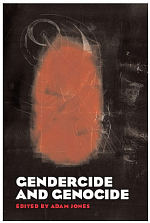
Statue at Vimy Ridge, France
[Link to full-size image.]
Pity the Innocent Men
by Adam Jones
The Globe and Mail, 20 February 1999
In September, 1996, after 14 months rotting in the woods and fields, the victims of the Srebrenica massacre are finally removed.
Among the skeletons is "evidence of a people hoping to survive," Associated Press reports: "loose pieces of clothing soiled by a year
of rains and snows, ID cards ... a pair of broken eyeglasses."
The 7,079 dead were victims of Europe's greatest atrocity since the Second World War. They shared two characteristics. They were
Muslim. And they were male.
The previous year, 450 Dutch UN troops had stood by as Serb forces under Ratko Mladic occupied the Srebrenica "safe area."
Thousands of men were rounded up. Thousands of women and children, along with several hundred men, made it to the UN base at
Potocari. Dutch troops watched as Serb soldiers entered the compound and selected women for sexual assault, men for torture and
execution. Elsewhere in the safe area, the mass killings of male detainees were already beginning. At least some of the Dutch knew
this.
The Dutch troops negotiated with the Serbs to evacuate the women and children to safety. In return, the peacekeepers compiled lists
of all males aged 17 to 65 in the UN compound. The Dutch expelled the 239 remaining Muslim men into the arms of waiting Serb
soldiers. Then they left, not even bothering to sound the alarm about the mass executions. All told, David Rohde writes in Endgame
(citing Red Cross sources), "nearly 3,000 men were summarily executed" at Srebrenica, and "over 4,000 hunted down like animals."
The following month, the UN again fled the field. The women, children, and very old men of another "safe area" -- Zepa -- were
evacuated, leaving about 3,000 "battle-age" men trapped. This time fortune was kinder. Ably led, almost all survived a hazardous
trek to Muslim-controlled territory.
Srebrenica's dead returned to the headlines in early 1996, when women from the city stormed Red Cross offices in Tuzla to protest
the stalled investigations into the fate of their missing relatives. "My husband was taken away, my brother too, like all the men," said
a young Muslim woman. The women's anguish was plain, and the passage of time had added practical concerns as well: "The
younger women have no hope of finding another husband until the death of the first husband has been proved," said a Red Cross
official.
Why would UN peacekeepers stand idly by as hapless male victims were carted off to the slaughterhouse? Why would they then expel
the remainder to face certain death? Somehow, the Dutch peacekeepers could not "see" the vulnerability of Srebrenica's men. "It
was not easy, watching wives and kids taken away from their men," said one Dutch corporal after the massacre. It neatly summarized
the prevailing mindset.
In numerous conflicts, men have been exposed to conscription, detention, torture and summary execution. Women and children,
despite vulnerabilities of their own, are more likely to receive safe passage through battle lines, as well as effective protection from the
UN and other international agencies. Even the men of threatened communities like Srebrenica tend to contribute to the bias, by
respecting the ancient edict of "women and children first."
In Canada, the issue of men's gender-specific suffering has been ignored. In March, 1993, the Immigration and Refugee Board (IRB)
introduced changes to the way it adjudicated refugee claims, with a document titled "Guidelines for Women Refugee Claimants
Fearing Gender-Related Persecution." The acceptance rate of women as refugees was already higher than that of men. But now
Bosnian and Croatian women, along with Somali women threatened with genital mutilation and Chinese women fearing forced
sterilization, could claim refugee status on the grounds of a "well-rounded fear of persecution" deriving from the "social traditions or
cultural norms" that threatened them.
Updating the guidelines in 1996, the board indicated that claims could be made on the basis of being forced into an arranged marriage;
or "failing to conform to ... certain gender-discriminating religious or customary laws," such as those governing "the wearing of make-up, the visibility or length of hair, or the type of clothing a woman chooses to wear."
The revised guidelines were even more resolute in their equation of "gender" with "women." "Gender is an innate characteristic," the
Board determined, "and, therefore, women may form a particular social group" under the Canada Immigration Act. "Although gender
is not specifically enumerated as one of the grounds for establishing ... refugee status [in the Act], the definition of ... [a] refugee may
properly be interpreted as providing protection for women who demonstrate a well-founded fear of gender-related persecution." A
careful reader could discern hints that women usually were not the ones most at risk. "Women frequently claim fear of persecution in
common with their male fellow citizens," the IRB noted, "though not necessarily of the same nature or at the same level of
vulnerability."
Between 1994 and 1998, the IRB finalized just under 1,500 gender-based claims. Female claims outnumbered male claims by more
than 7:1 (1,320 to 178), although the acceptance and rejection rates were roughly equal. The new female-focused IRB initiative was
followed by similar moves in the United States and Australia, two other leading sanctuaries for refugees.
This new emphasis on gender-based suffering opened up vital new avenues of analysis and activism: around women's vulnerability to
sexual violence, for example. But where is the evidence to show that this overwhelming emphasis on women is warranted? Indeed,
the double standard is so deeply embedded that the term "gender" has now come to be used interchangeably with "women." It has yet
to be widely acknowledged that men face discrimination that is both systematic and injurious.
For example, the practice of gender-selective military conscription is so widely accepted that we have lost the ability to see it for what
it is: namely, perhaps the most ubiquitous, severe, and physically destructive act of gender-specific discrimination of all. Why is
conscription not considered a "social tradition or cultural norm," capable of harming men every bit as severely as women are harmed
by domestic violence, genital mutilation or fundamentalist harassment?
Just as women experience marginalization and physical victimization in subtle ways, economic and social structures also inflict
devastating damage on men. Summary detention and execution, the travails of international migrant labourers, eunuchry, hazardous
work, abbreviated life expectancy, incarceration and sexual abuse in prisons, alcoholism and drug-addiction, homelessness and suicide
- all affect men disproportionately.
Just how deeply the double standard is embedded was driven home when I sought to engage the president of the International Centre
for Human Rights and Democratic Development (ICHRDD) on the Balkans issue. Edward Broadbent was one of the staunchest
supporters of the IRB initiative. I wrote to him in early 1994 to express the concerns I have raised in this article.
I asked that the ICHRDD take the lead in confronting acts of injustice and unwarranted discrimination against males, including acts of
political violence such as preventive detention, incarceration and execution. Despite the supposed benefits accruing to their sex, men
in a conflict zone may be every bit as exposed and vulnerable as any woman or child - usually a good deal more so. The unspoken
assumption, though, is that because they are male, they are complicit in their own victimization.
On Nov. 8, 1994, I received a three-sentence response signed by Mr. Broadbent's assistant, who thanked me for my "reflections on
the term 'gender'." My letter, although "very interesting," concerned itself with issues that were "not part of our mandate." Eight
months later came Srebrenica. The following year, the ICHRDD founded an international Coalition on Women's Human Rights in
Conflict Situations.
Last November, right-wing militias in Colombia, "using chainsaws on some of their victims, killed 11 peasants and kidnapped 13
others, accusing them of collaborating with leftist guerrillas," according to an Associated Press report. Ten of the 11 peasants were
men. The eleventh was a young woman who was killed by militiamen seeking her husband.
These ghastly events occurred in Antioquia, the most violent province in the most atrocity-ridden country on earth. "In this macho
society," wrote Ken Dermota in The Globe and Mail, "women are protected and only the men are murdered, leaving about a thousand
widows in the region [around the town of Uraba]." Again the IRB's pontifications on "social traditions" and "cultural norms" leapt to
mind.
Later in November, Edward Broadbent and the current chairman of the ICHRDD, Warren Allmand, addressed a conference in
Edmonton on "Universal Rights and Human Values," commemorating the 50th anniversary of the Universal Declaration of Human
Rights.
With much fanfare, participants drafted "The Edmonton Resolution: A Blueprint for Peace, Justice, and Freedom." The resolution
called "upon all states to promote and protect the human rights of all citizens, and especially those of women [and] girl children."
Supplementary Materials
(access a full list through the "Gender Page" of the site)
"Gender and Ethnic Conflict in ex-Yugoslavia," Ethnic and Racial Studies (Routledge), 17: 1 (January 1994), pp. 115-34. (Examines
both sides of gender-specific and gender-selective suffering in the Balkans war.)
"Terminal Sexism," a briefer and more polemical version of the argument in "Gender and Ethnic Conflict," originally published in
Balance magazine and copyright-cleared for educational use.
"Does 'Gender' Make the World Go Round? Feminist Critiques of International Relations," Review of International Studies
(Cambridge University Press), 22: 4 (October 1996), pp. 405-29. (Winner of the British International Studies Award prize for best
Review article of 1996. The concluding section, "Towards an international politics of gender" (pp. 420-29), buttresses many of the
arguments made in the Globe and Mail article with empirical evidence drawn from diverse case-study countries and issue-areas. It is
suitable for excerpting as a stand-alone reading: copyright clearance via Cambridge University Press.)
"Engendering Debate," Review of International Studies, 24: 2 (April 1998), pp. 299-303. (A response to Carver et al., "Gendering
Jones," in the same issue of the Review.)


